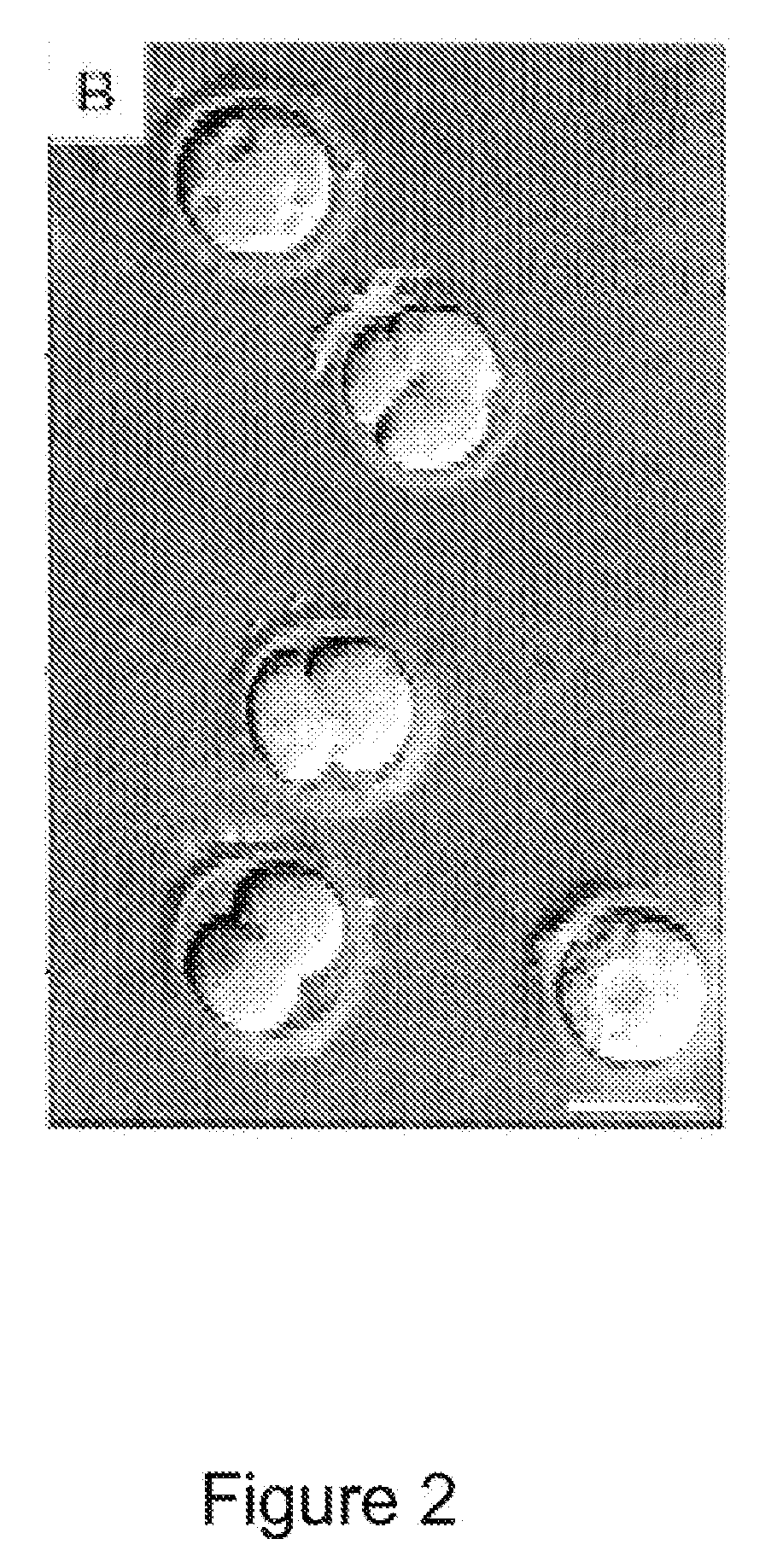Methods for making and using reprogrammed human somatic cell nuclei and autologous and isogenic human stem cells
a technology of human somatic cell nuclei and autologous and isogenic human stem cells, which is applied in the field of therapeutic cloning, can solve the problems of difficult to obtain a good match between the mhc proteins of the recipient's cells or tissues available for transplantation, the transplant recipient must rely on heavier doses of immunosuppressive drugs, and the cloning of primate embryos, including humans, has been problematic and has yet to be reported
- Summary
- Abstract
- Description
- Claims
- Application Information
AI Technical Summary
Benefits of technology
Problems solved by technology
Method used
Image
Examples
example 1
Protocol for Reprogramming Human Somatic Cell Pronuclei by Somatic Cell Nuclear Transfer
[0139]A. Oocyte collection:[0140]1 Oocytes are aspirated from ovarian follicles using an ultrasound-guided needle at 33-34 hrs post hCG administration.[0141]2 Oocytes are denuded of cumulus cells by pipetting up and down using a finely pulled pipette in 1 mg / ml hyaluronidase in Hanks medium.[0142]3 After removing the cumulus cells, the oocytes are placed in Hanks medium with 1% bovine serum albumin (BSA) or with 1% human serum albumin (HSA), and are transported to the laboratory where nuclear transfer procedure is to be performed.[0143]4 Within 1-2 hours after recovery, the oocytes are placed in a drop of 500 μl of G1 (SERIES III) with 5 mg / ml HSA culture medium under mineral oil and are incubated at 37° C. in 6% CO2 in air until nuclear transfer procedure is performed. Oocytes obtained by this procedure can also be activated to produce a parthenogenetic embryo that can be used for the generation...
example 2
Superovulation and Oocyte Retrieval
[0176]Oocyte donors were 12 women between the ages of 24 and 32 years with at least one biologic child. They underwent thorough psychological and physical examination, including assessment by the Minnesota Multiphasic Personality Index test, hormone profiling, and PAP screening. They were also screened carefully for infectious diseases, including hepatitis viruses B and C, human immunodeficiency virus, and human T-cell leukemia virus. Donor ovaries were down-regulated by at least 2 weeks of oral contraceptives, followed by controlled ovarian hyperstimulation with twice daily injections of 75-150 units of gonadotropins. Pituitary suppression was maintained in some donors by concomitant twice daily administration of Synarel, beginning 3 days before discontinuing oral contraceptives and 5 days before initiating gonadotropin injections, and in other donors by injection of Antigone beginning with leading follicle diameters of 12 mm. Ovarian stimulation ...
example 3
Reprogramming Human Somatic Cell Nuclei / Chromatin in Embryos Reconstituted by Nuclear Transfer
A. Somatic Cell Isolation
[0178]Adult human fibroblasts were isolated from 3-mm skin biopsies for use as somatic nuclear donor cells. The people from who the skin biopsies were taken from consenting adult volunteers of varying ages who were generally healthy, or who had a disorder such as diabetes or spinal cord injury that might benefit from therapeutic transplantation of autologous cells produced by cloning by nuclear transfer. Skin explants were cultured for 3 weeks in DMEM (Gibco, Grand Island. N.Y.) plus 10% fetal calf serum (HyClone, Logan, Utah) at 37° C. and 5% CO2. Once cellular outgrowth was observed, fibroblasts and keratinocytes were enzymatically dissociated using 0.25% trypsin and 1 mM EDTA (GibcoBRL, Grand Island, N.Y.) in PBS (GibcoBRL) and passaged 1:2. Fibroblasts were used at the second passage. The identity of these cells was later confirmed by immunocytochemistry, and se...
PUM
| Property | Measurement | Unit |
|---|---|---|
| inner diameter | aaaaa | aaaaa |
| diameters | aaaaa | aaaaa |
| immune-compatibility | aaaaa | aaaaa |
Abstract
Description
Claims
Application Information
 Login to View More
Login to View More - R&D
- Intellectual Property
- Life Sciences
- Materials
- Tech Scout
- Unparalleled Data Quality
- Higher Quality Content
- 60% Fewer Hallucinations
Browse by: Latest US Patents, China's latest patents, Technical Efficacy Thesaurus, Application Domain, Technology Topic, Popular Technical Reports.
© 2025 PatSnap. All rights reserved.Legal|Privacy policy|Modern Slavery Act Transparency Statement|Sitemap|About US| Contact US: help@patsnap.com



